Most Europeans are not very connected to far eastern football like the J1 League in Japan.
If you were to ask random football fans to name Japanese Teams, they would probably name the likes of Vissel Kobe, but only because players like Andrés Iniesta or David Villa have played there after leaving Barcelona.
The name Machida Zelvia definitely would not ring any bells for most football fans; the team wasn’t even well-known in Japan.
In the last couple of years, Machida was caught up in the relegation battle in the J2 League, merely avoiding relegation into the third Japanese division of football.
Two years ago, things drastically changed for the club, however.
Not only did they get some financial backing from a minority shareholder, which didn’t do too much, to be frank, but they also hired Go Kuroda as the team’s new manager, getting promoted in their first season and fighting for the championship in his second season.
Machida Zelvia is the first coaching gig for Go Kuroda in professional football, but his name was still well known in the Japanese footballing world.
Kuroda took over a completely unknown high school football program at Aomori Yamada High School in the early nineties.
The school had horrible training facilities, and Kuroda had no managerial experience.
The school’s location in the north of the country also didn’t help the team.
Still, Kuroda managed an unbelievable turnaround in a short amount of time, making the school one of the best teams in the country and becoming the national champion and multiple-time champion of the Prince Takamado Cup.
He was considered the best high school coach in the country for multiple years, coaching the team until the conclusion of the 2022 season.
In 2023, Kuroda took on the challenge of a struggling FC Machida Zelvia in the J2 League without having worked with grown men before that point.
Machida, considered the “Brazil of Tokyo,” is a town in the greater Tokyo area with a rich football history and culture.
The move came as a huge surprise to most people and was not received well by the majority of experts at the time.
Kuroda and Machida Zelvia managed to overcome those expectations easily, however, securing promotion in the 2023 season.
Currently, the team leads the J1 League with 49 points, four points clear of second place in their first-ever J1 League season.
Are we witnessing a football miracle in a football-breathing town led by a high school football legend?
Or are FC Machida Zelvia not as good as a short view on the table might make them look?
In this Go Kuroda tactical analysis, we will provide an analysis of how the freshly promoted side has taken the J1 League by storm and what to expect for the rest of the season.
Go Kuroda Formations & Players Used
In modern football there usually is something really cool about the way successful managers line up their teams and how they change their formations and tactics every single week to adapt to the opposition.
With Go Kuroda and Machida Zelvia, it’s quite different.
Kuroda sticks with his 4-4-2 in every single game—no inverted full-backs, false nines, or any of that.
In Machida, the game is, in fact, not gone yet.
In terms of players, Kuroda was forced to make a couple of changes during the course of the season for varying reasons.
In goal, Tani is the number one for Machida Zelvia.
In the back four, three spots have been taken for the entire season, with Hayashi playing on the left and Dresevic, a Bosnian international, and Shoji, who has already played in Europe for Toulouse, being paired up in the middle of the line.
On the right side, Mochizuki has taken over the starting spot from Suzuki over these last couple of weeks.
In midfield, captain Sento is leading the double pivot, being paired up with either Shibota or Shimoda.
Fujimoto has been the regular starter on the left, and Na has been starting on the right wing for the last couple of games.
Up front, Kuroda has put a lot of trust in the pairing of experienced Oh and young Japanese striker Fujio.
However, he had to change his plans in these last games because Oh was injured, and Fujio has been travelling to Paris with the Japanese U23 National Team.
For those two, freshly recovered Erik and Australian Duke have taken over the striker positions for Machida Zelvia.
Heavy Focus On Long Balls & Wing Play
Usually, the top teams in their respective leagues dominate their matches and keep more possession of the ball than average at least.
With Machida Zelvia, we have a huge exception to the rule.
Kuroda’s men only have a possession percentage of 44%, ranking third to last in the entire J1 League.
Still, they are comfortably leading the league.
With only 269.89 passes per 90 minutes, Machida Zelvia even ranks second to last in the league.
The team does not value possession or continuous passing very highly, making them a very special case in today’s football world.
Kuroda prioritises long passes over short ones and wants his team to not waste time and quickly attack the opposition’s backline.
With 44.68 long balls per game, Machida Zelvia ranks sixth in the league in terms of long passes per 90 minutes.
Go Kuroda is a coach who wants to work and fight football rather than play it.
This may sound harsh, but if we look at the statistics for the J1 League season so far, Machida Zelvia is pretty much below average in every meaningful number you can look at.
Still, they are able to beat most of their opposition convincingly, and their build-up with their long ball is their set-up for success.
Before the season started, the club was able to sign two experienced centre-backs, Gen Shoji and Ibrahim Dresevic.
These centre-halves excel at playing long balls in the first phase of play.
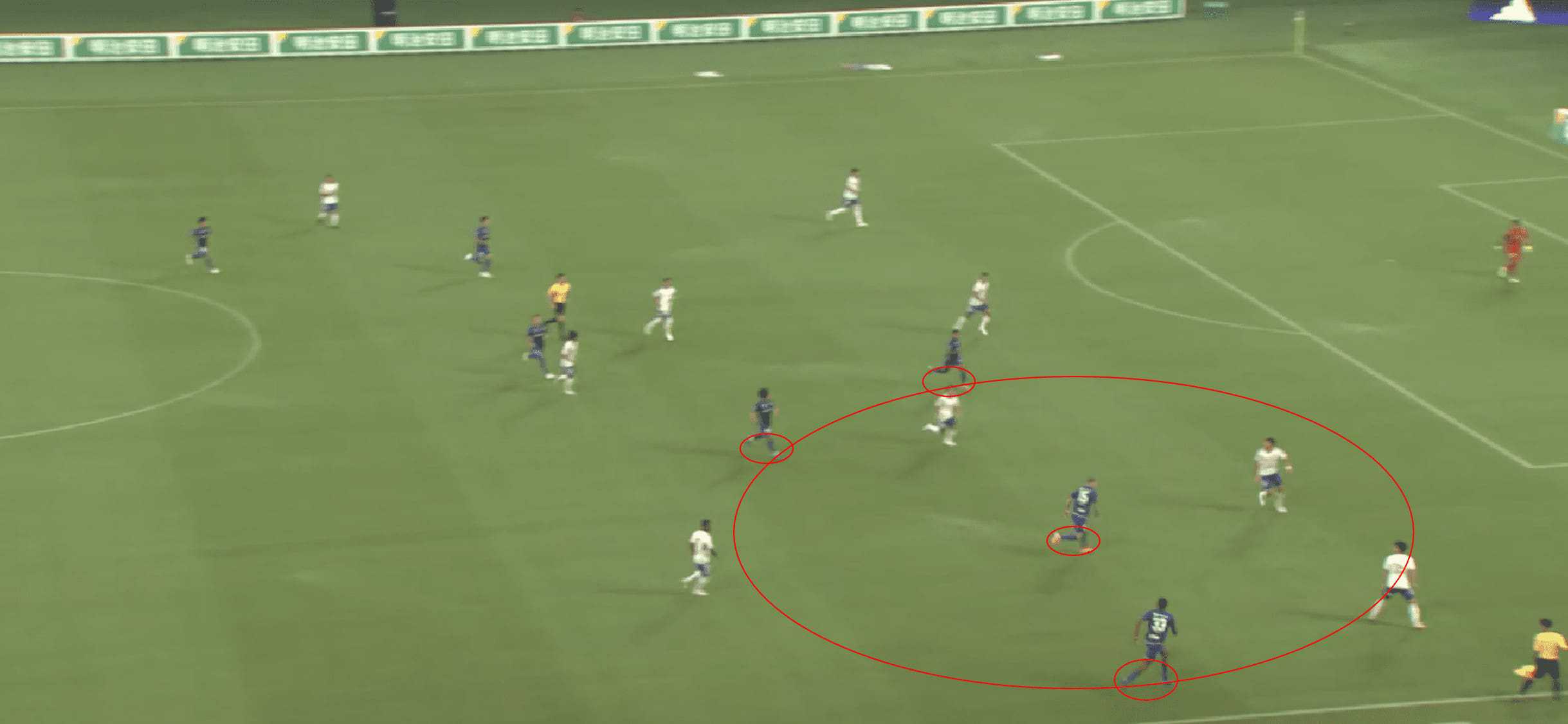
In this situation, we are merely a couple of seconds after the kick-off of the game.
Machida Zelvia is in possession of the ball and instantly shows the team’s intentions.
The team overloads the right side of the pitch and moves right towards the opposing backline, opening up the possibility for a long ball.
Shoji does not hesitate one second and instantly punts the ball towards that side of the pitch.
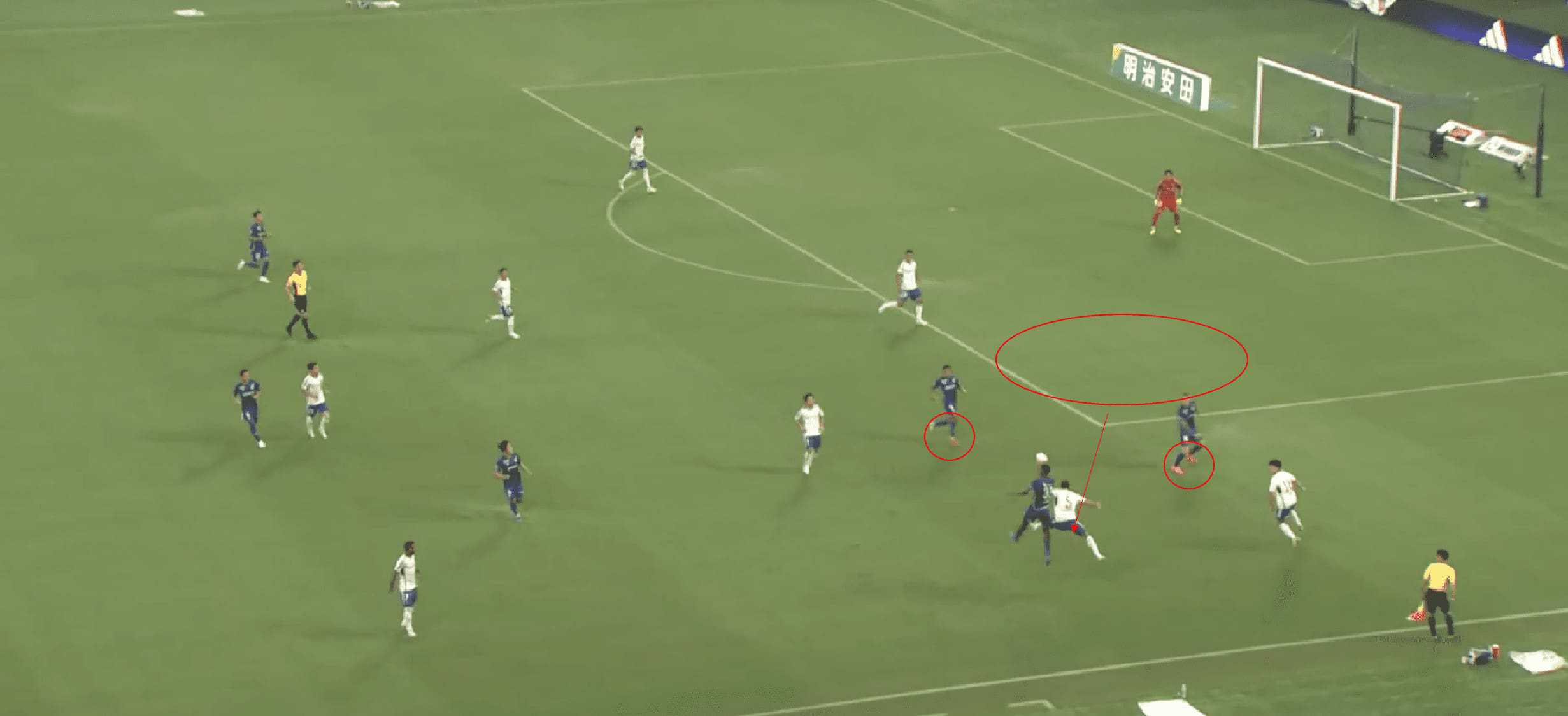
Shoji finds his right-back, who is a towering 1.92m tall, and he is able to instantly head on towards his teammate.
The ball is not perfect, but there was the opportunity to instantly move towards goal.
After that, Kuroda’s men instantly form a diamond on the wing, opening up the passing game on that side of the pitch for them.
Another big part of the build-up play of Machida Zelvia is their ability to play the second ball.
Every team that plays with this many long balls needs to have a plan to get to the second ball quickly.
Even the best players in the world can not place long balls in a way that makes their teammates able to control every single long pass.
Therefore, long passes are always an element of play that creates a bit of chaos and moments of disorientation for both teams.
Kuroda sets his team up to be the master of the chaos, allowing them to catch their opposition off-guard rather often.
Here we are looking at a long ball played by the keeper of Machida Zelvia.
The team positions in a way that they are overloading the right side of the field once again.
This not only gives the keeper the option of playing the ball towards multiple targets, but it also generates a numbers advantage in this area for Kuroda’s men.
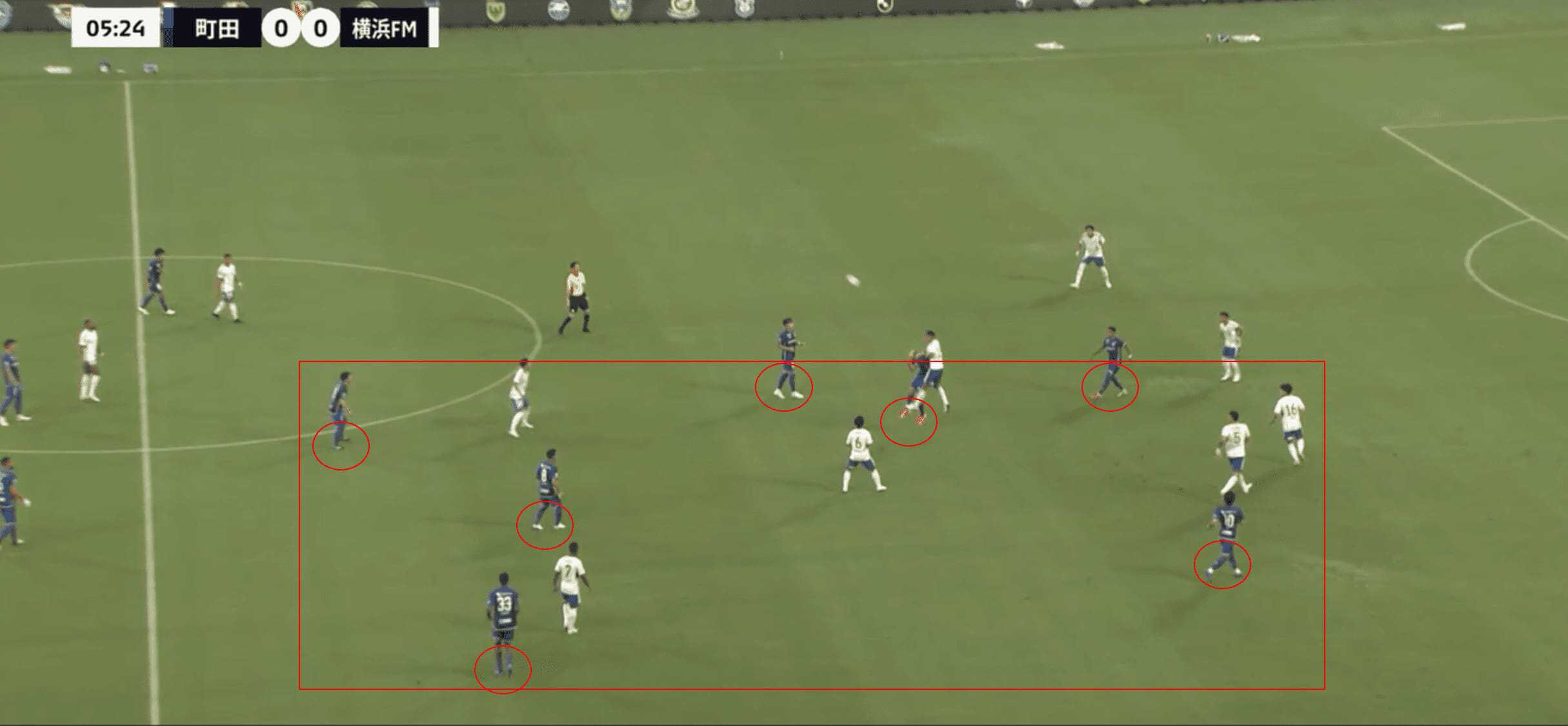
The keeper plays a great long ball right towards the target man in Duke, who tries to gain possession of the ball by winning the aerial duel.
The players around Duke are threatening the defensive line with runs on one hand but are also ready to win the ball back if the ball can’t be controlled by the striker.
In this situation, Duke gets fouled, but Machida was still winning the second ball.
Kuroda’s team is not afraid of physicality or taking on defensive duels, in these situations they are always eager to win the ball back quickly.
This is a form of counterpress that has proven to be very effective for Machida Zelvia this season and the starting point for most of their attacks.
Another great example is the penalty Kuroda and his team received against Gamba Osaka.
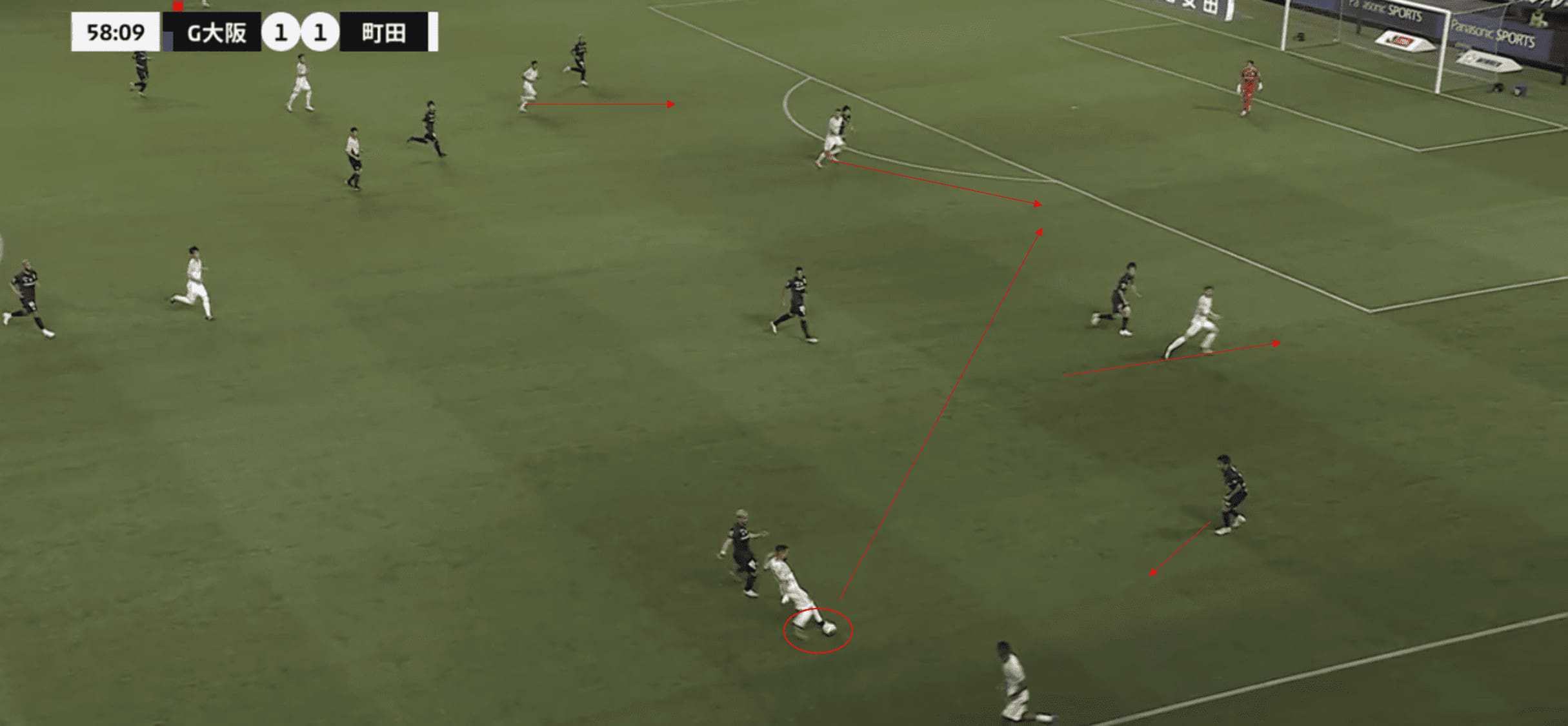
Here, the right centre-back is moving forward, looking to play either onto the wing or a long ball.
The right-back is moving towards the ball, dragging one defender out of position. This is used by three players making deep runs, which allows a long ball to be played to multiple options.
Here, the ball is once again played towards Duke as a target man.
Duke now has multiple options after receiving the ball because both Erik and Fujio are making runs into the area as well.
Duke decides to play the easy lay-off towards Fujio, who is fouled and scores the resulting penalty.
Two passes lead to an easy goal, precisely what Kuroda wants to see from his men.
Wing Play and Crosses
Go Koruda pretty much tries to skip the transitional phase of play and move on towards the attacking play quickly.
Even if Machida Zelvia is not playing long balls, they are trying to push the ball into the final third with only as many passes as necessary.
Most of the time, the ball-near midfielder pushes up the field, opening the pass window to the wingers or full-backs.
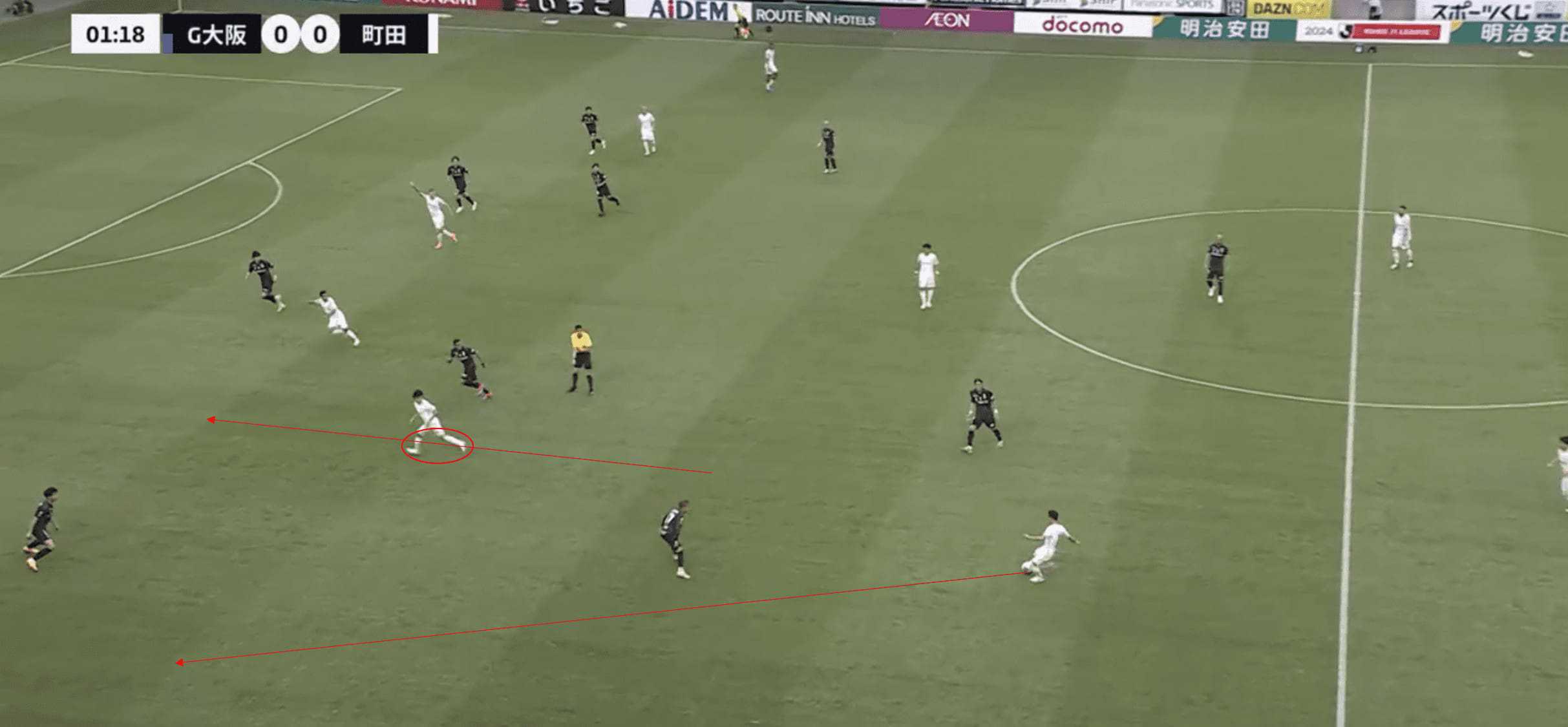
The wingers receive the ball very wide but are in isolated 1v1 situations most of the time.
From there on, their teammates try to provide the support necessary to attack the space behind the full-back and create a passing opportunity.
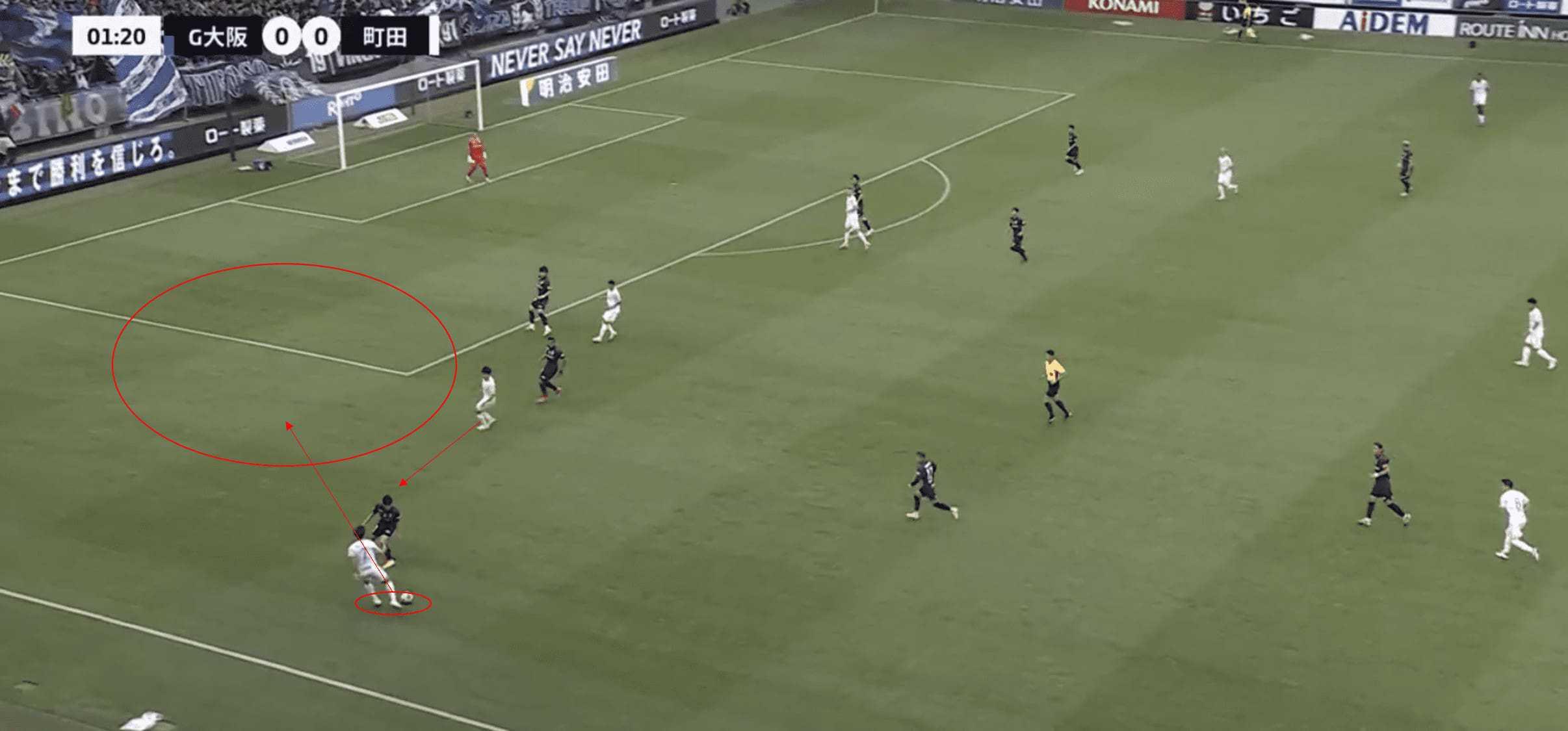
Machida Zelvia is one of the best teams in terms of crossing in the J1 League.
This has multiple reasons.
Firstly, the team obviously tries to create as many good crosses as possible in a game.
Most of the passes into the final third of Kuroda‘s men are passes to the outside, and the formation they are using allows them to have wide players ready to cross as fast as possible at all times.
Secondly, they have two strikers, one midfielder, and one winger on the opposite side of the pitch, making runs into the box.
This allows the wingers and full-backs to consider targets to cross to, which makes their jobs an awful lot easier.
Machida Zelvia is the team with the fourth most crosses per 90 minutes in the J1 League.
But it’s not just the volume; they also have a success rate of 38.8% with these crosses, ranking second in the league.
Another huge factor is the placement of their crosses.
Their 67 crosses into the six-yard box are also second in the league.
As with long balls, crosses are always a bit hard for players to control, and the majority of crosses are not successful.
Again, it is very important to get the second ball to start another wave of attack quickly.
Machida Zelvia are excellent at winning these balls after crosses, as well as long balls.
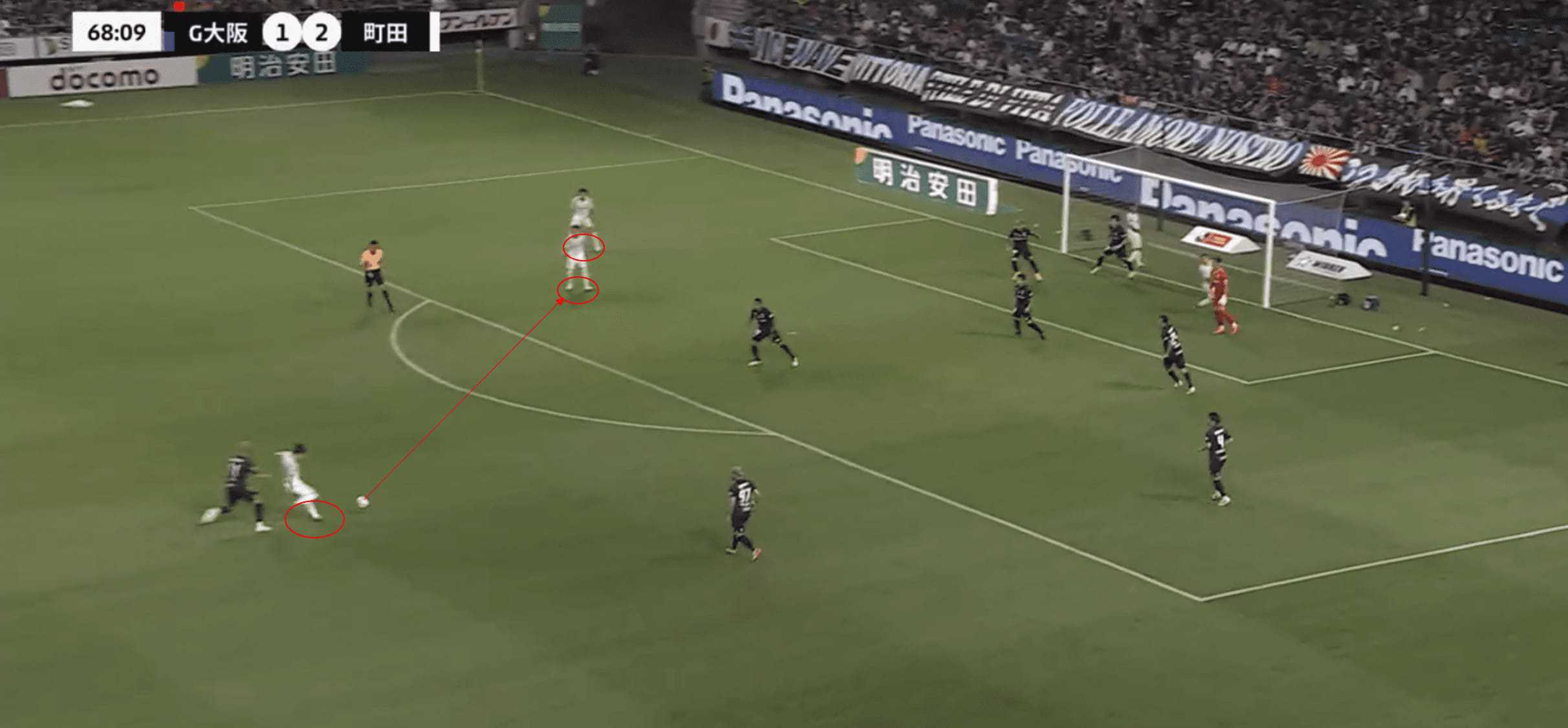
Here, Machida Zelvia was able to create another good scoring opportunity over their wing, but they could not finish the chance.
The ball gets cleared out, and Kuroda’s team is in the perfect position to intercept it, no matter where it ends up.
Here, the holding midfielder can get to the loose ball first and plays an easy pass into the box, where Machida Zelvia has multiple players ready to receive the ball in space again.
In this situation, they were able to even finish the chance of, closing the game with a two-goal lead.
Go Kuroda is not a tactician like Pep Guardiola or Mikel Arteta, who tries to dominate with tactics like positional play or total football.
The Japanese coach is taking a very pragmatic approach to the game.
He allows his team to easily enter the final third and creates opportunities with crosses.
This throwback-style football has worked exceptionally well for the team in consecutive years, proving that there are many ways to win football games.
Kuroda’s tactical approach has definitely surprised a lot of teams and has put Machida Zelvia in a very good position in the championship race.
The Duality Of The 4-4-2 Against The Ball
When you’re in possession of the ball, the opponent can’t score a goal.
That’s a pretty easy-to-understand concept that many top teams in the world use right now to concede as few goals as possible during the season.
If you want to be recognised as a top team, you better have a good defence.
Go Kuroda and Machida Zelvia obviously can’t use their dominance of possession to prevent the opponent from scoring because they are not in possession for the majority of the game.
Still, Kuroda’s men have the second-best defence in the J1 League right now, conceding only 19 goals in 24 matches.
They are not just great at preventing the opponent from scoring, they are also allowing only 9.02 shots per 90 minutes to their opposition, ranking second-best in the league in that category.
But they don’t just allow very few shots for their opposition; they also block 31.2% of the shots they are facing, which is the best number in the entire league.
This combination is deadly for opposing offences, as they cannot create many goal-scoring chances against Machida Zelvia and Go Kuroda.
On average, Kuroda’s men allow only 1.03 xGA per game, an insanely good value.
In this paragraph, we will examine how Kuroda uses his throwback 4-4-2 formation to hone his defensive skills.
The 4-4-2 is not used as often as it was in the past because of its weaknesses in positional play and pass connectiveness.
Still, there are a couple of teams that are using the formation to this day, and they are divided into two types:
First is the RB-type, where the Red Bull teams use the formation for their high and intense attacking press.
Second, there are a lot of teams that are using the 4-4-2 to defend in a low block when in front.
Kuroda uses both types in his matches, which makes Machida Zelvia so lethal in defending.
High Press
Even when not having the ball, Go Kuroda and his men try to be as active as possible and gain control of the game by pressing up high.
One of the things that Machida Zelvia is doing great, is cutting off one side of the pitch after a pressing trigger.
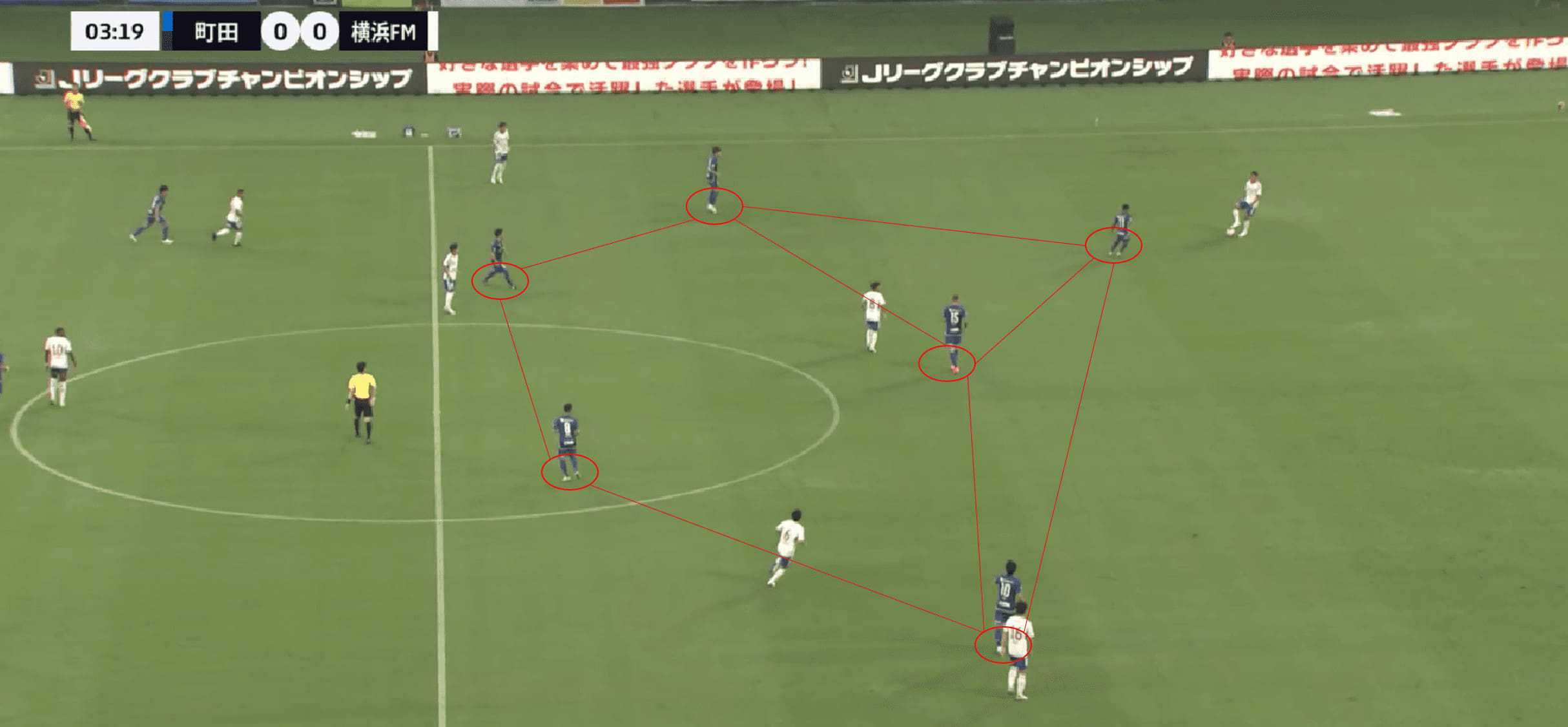
Here, Machida Zelvia is pressing in a 4-2-3-1 shape, with the far-sided striker in Duke falling back into the midfield.
This allows the team to stay patient and still be in control of the most essential spaces all over the pitch.
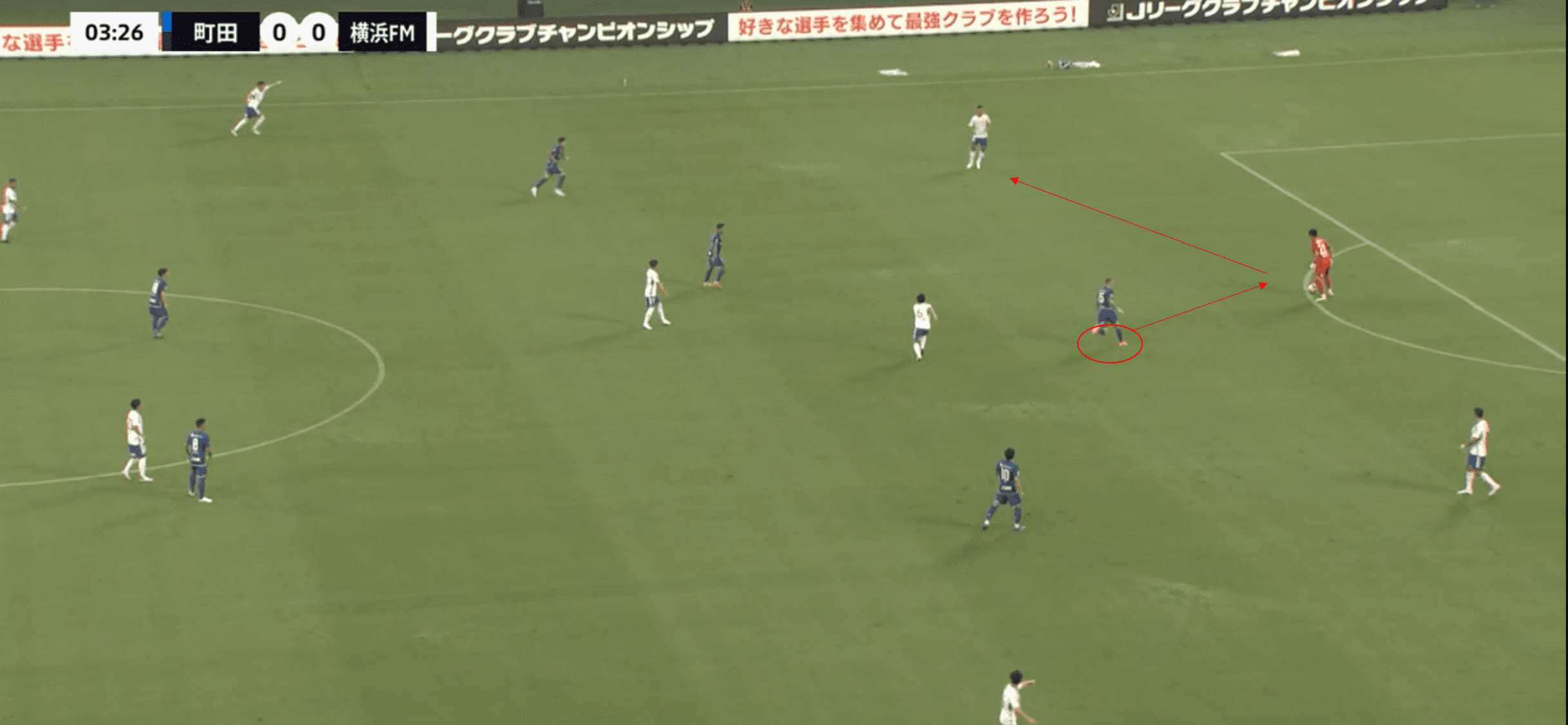
After two more passes, Duke triggers the press after the keeper receives the ball on a backward pass.
Machida Zelvia is now pressing out of their 4-2-3-1 shape, with Duke cutting off the right side of the field, forcing the keeper to pass the ball to the other side.
There, the centre-back is under huge pressure from the pressing attackers of Machida Zelvia.
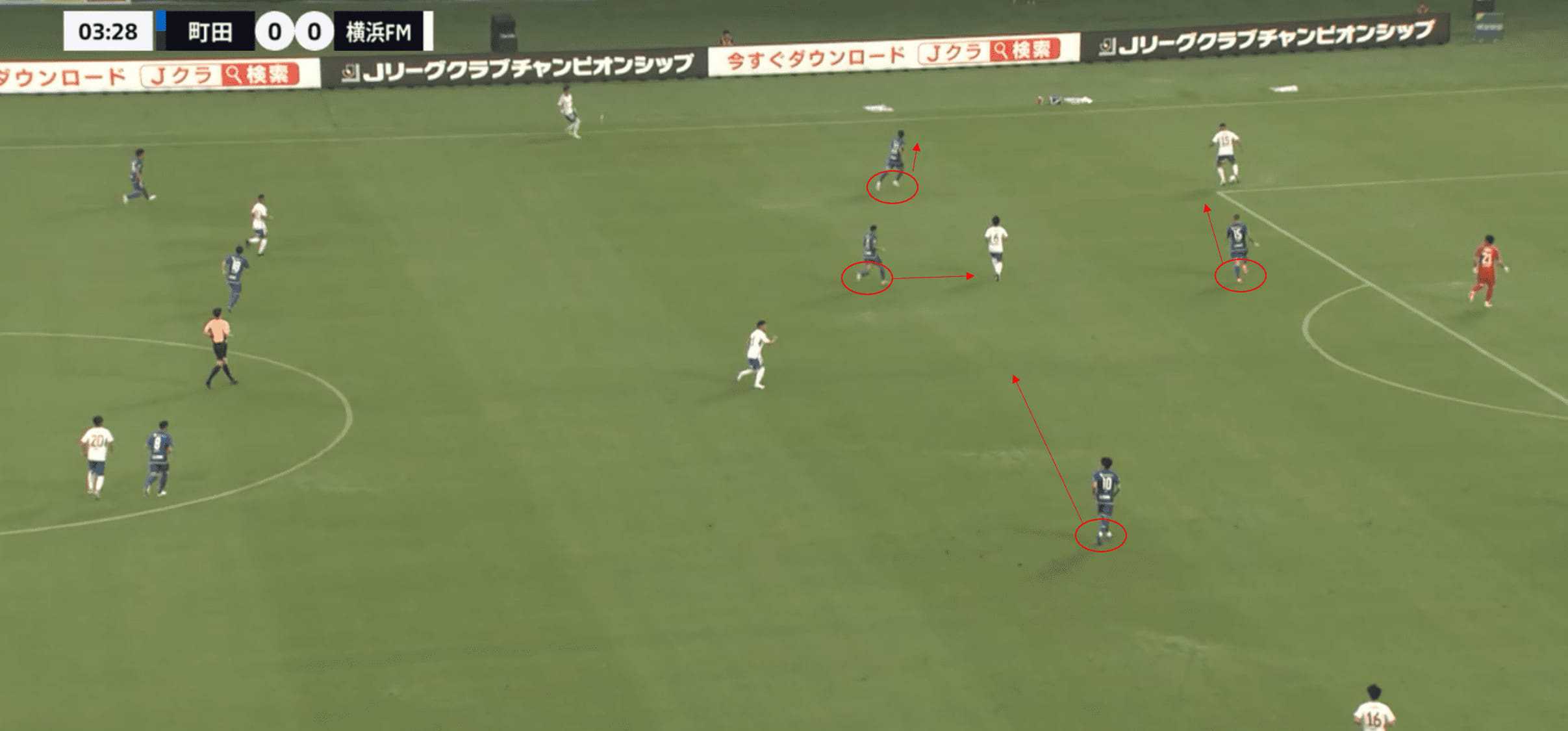
The centre-back is out of options and cornered near the sideline, a perfectly executed press like Kuroda wants his man to attack the build-up.
Machida Zelvia is not winning a lot of balls up the field with their type of press, but they are always stressing their opponents and forcing long balls that are rather easy to defend.
This is the first part of the successful defence Kuroda has been establishing this season.
Their attackers are their first defenders, and this pays off big time.
Low Block
If the opposing team manages to play through the first phase of pressing that Kuroda and his men are playing, they fall back into a low block most of the time.
Of course, they also use this tactic when they are in the lead of games.
This has proven to be one of the most vital points in play for Machida Zelvia this season; the team has taken the lead 16 times this season, winning 15 of those games and drawing one, which means that Kuroda and his men have not lost a single game after going in front.
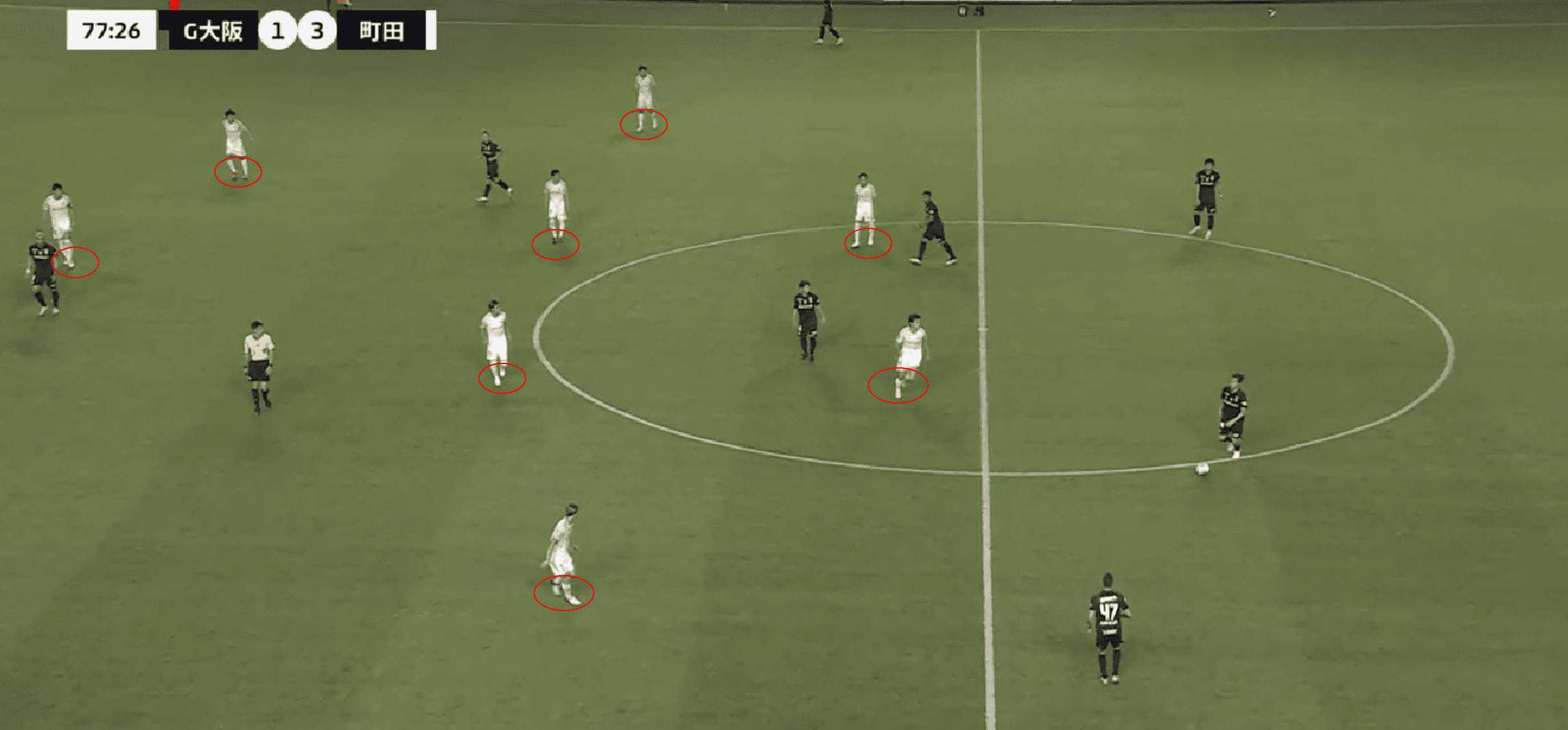
Here, we can see the 4-4-2 very clearly.
The entire team stays calm and composed until the opposing team tries to play the ball into the Machida Zelvia side of the field.
Then, they start to press from the inside to the outside, prioritising the centre and pressing only the ball on the wings.
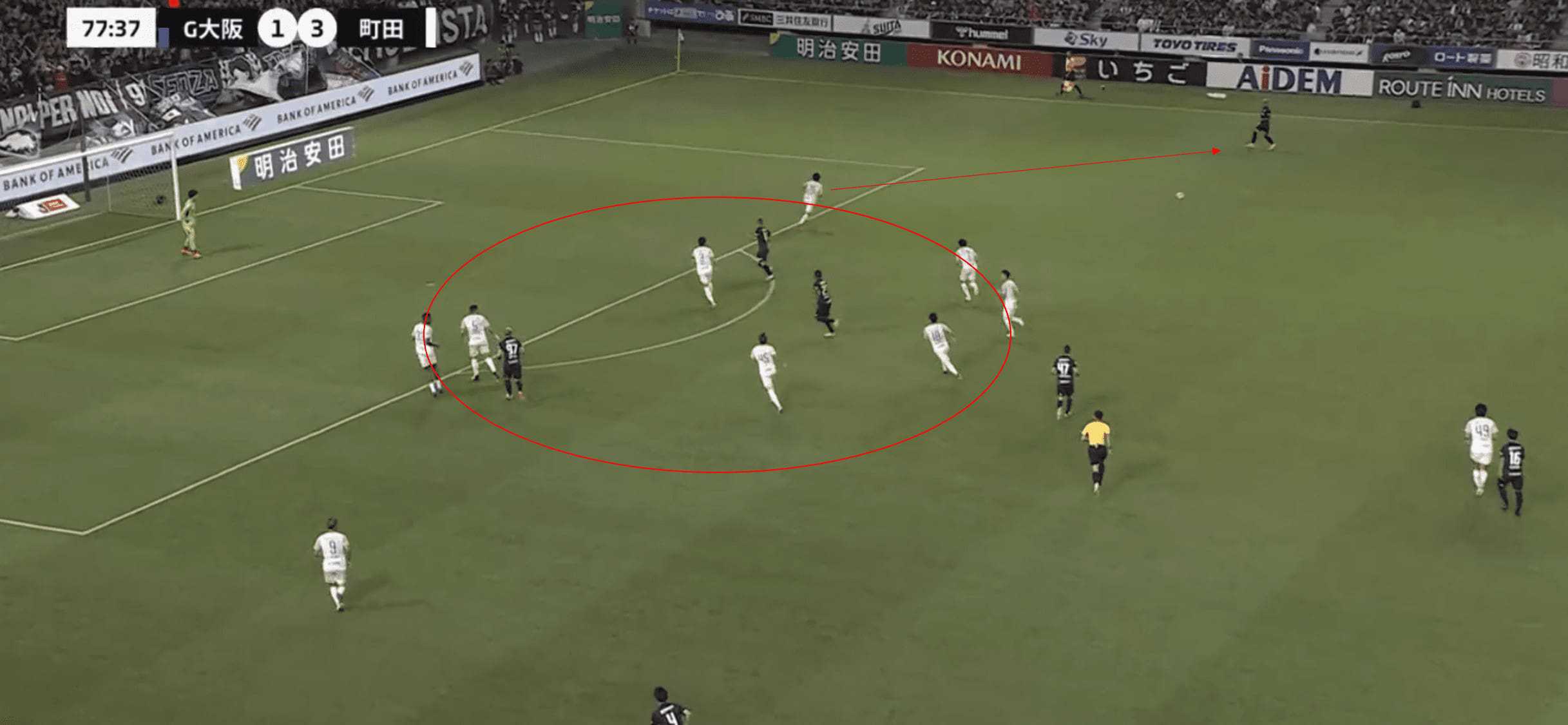
Here, we can see that they are covering the middle of the field with a lot of players and leaving the wings relatively open.
Suppose they can move over collectively in time. In that case, Kuroda’s men will try to win the ball back near the sideline, where the opponent does not have many options, while Machida Zelvia has a winger and a full-back out there, they do not get there in time; they can simply defend the cross with the numbers advantage they are holding in the middle of the field and the box.
This style of defending is rather basic and uses the absolute basic principles of defending in football.
Still, Kuroda makes his men execute these principles exceptionally well, which shows in their defensive stats.
Another big factor is the distance the team covers without the ball, ranking fourth in this statistic in the J1 League, showing that Kuroda managed to elevate the fitness level of his team in his tenure.
Conclusion
Being rich in football culture, the city of Machida and the fans of FC Machida Zelvia deserve all the success in the world.
The move of hiring a high school coach in Go Kuroda was definitely risky, but it paid off for the club big time.
Kuroda has turned around the club in only two seasons, taking over a midfield team in the second division and becoming a valid championship contender in the first season after a surprise promotion.
While nobody can dispute Kuroda’s coaching abilities at the youth level, there were a lot of questions about his jump to the senior level, but he managed to prove all his doubters wrong.
If you expect Go Kuroda to dominate the league with advanced, never-before-seen tactics, you will probably be disappointed after watching a couple of games of Machida Zelvia, but you honestly shouldn’t be.
Throwback-style football, which focuses on the basics of the game, is very entertaining to watch.
It proves that there are many ways to win games in football.
Johan Cruyff once said: “Playing soccer is very simple. But playing simple soccer is the hardest thing.”
Kuroda is making his team do exactly this.
However, it needs to be addressed that Kuroda’s team also has some struggles, especially in possession.
They are also below average in a lot of statistics, and that’s a dangerous line to balance.
Their great set pieces and their not losing any points after going in front are a very strong combination for the team, but Machida Zelvia’s tactics will need to improve with the ball if they want to hold on to their five-point-lead to win the J1-League this year.

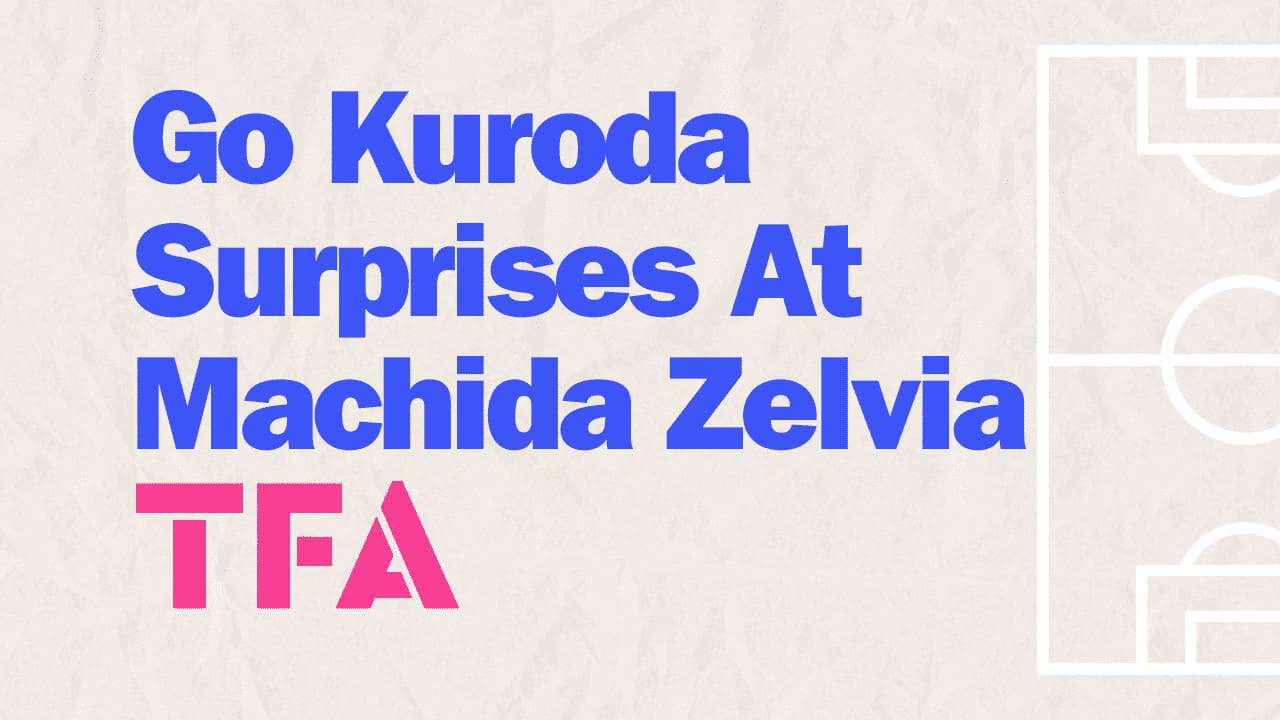




Comments